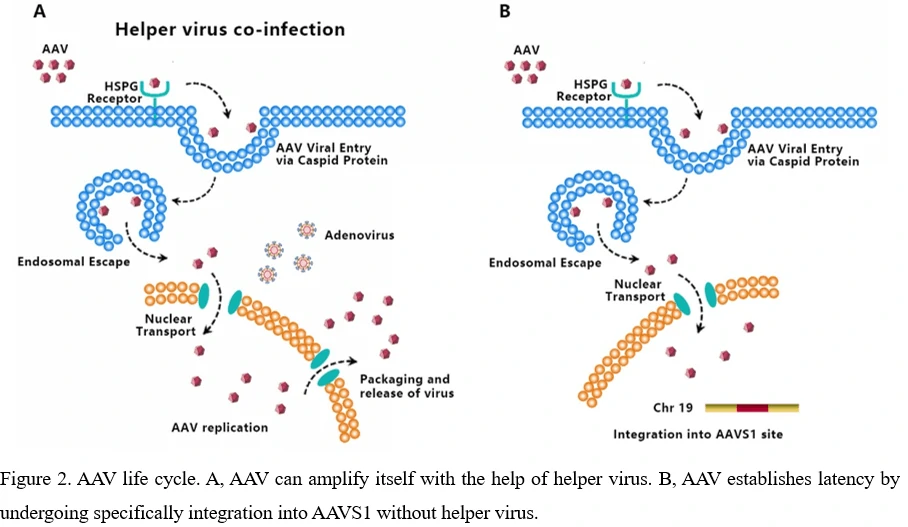Life Cycle of AAV Virus-From Infection To Regeneration
 AAV protocol Download
AAV protocol Download
Adeno Associated Virus (AAV)
AAV transduces cells through several stages: (1) viral binding to cell surface receptor/coreceptor, (2) endocytosis of the virus, (3) intracellular trafficking of the virus through the endosomal compartment, (4) endosomal escape of the virus, (5) intracellular trafficking of the virus to the nucleus and nuclear import, (6) virion uncoating, (7) viral genome conversion from a single-stranded to a double-stranded genome capable of expressing an encoded gene [34-36]. Since AAV can't encode polymerases, AAV is dependent upon cellular polymerase activity to replicate its own genome [37]. The presence of a helper virus such as adenovirus is indispensable for wild-type AAV to facilitate gene expression and replication. (Figure 2A) Without helper virus, expression of Rep68/Rep78 would be restricted owing to Ying Yang 1 (YY1) repression of the P5 promoter, leading to inhibition of AAV genome replication and gene expression, and initiation of AAV chromosome integration (Figure 2B) [38]. AAV establishes latency by undergoing specifically integration into a genome site, termed as the adeno-associated virus integration site 1 (AAVS1), a 4kb region on chromosome 19 (q13.4).

So far, no known disease has been demonstrated to be related to AAV though AAV has been detected in many tissues of animal species. Serological studies show that most people are exposed to wild-type AAV during childhood and adolescence and prevalence rates for antibody titers exceed 60% among adults, while no detrimental effects or lytic infections have been observed [39,40].
GeneMedi's AAV vector system
GeneMedi offers AAV(Adeno-Associated Virus) vector system and AAV Vector Systems-Kanamycin Resistance (AAVKan system), the serotype includes:
| Common Serotypes | AAV1, AAV2, AAV4, AAV5, AAV6, AAV6.2, AAV6.2FF, AAV8, AAV9, AAV-Rh.10, AAV-DJ, AAV-Retro (Retrograde), AAV-PHP.B, AAV-PHP.eB, AAV-PHP.S, AAV-BR1, AAV-2i8, AAV-SIG, AAV-VEC. |
| AAV2 Variants | AAV2 variant (Y444F), AAV2 variant (Y272F, Y444F, Y500F, Y730F), AAV2 variant (Y444F, Y730F, Y500F, Y272F, Y704F, Y252F), AAV2 variant (AAV2.7m8). |
| AAV8 Variants | AAV8-1m, AAV8-2m, AAV8 variant (Y733F, Y447F, Y275). |
| MyoAAV Series | AAV-MyoAAV1A, AAV-MyoAAV2A, AAV-MyoAAV3A, AAV-MyoAAV4A, AAV-MyoAAV4E. |
| Other Specialized Variants | AAV-Anc80, AAV-rh74., AAV-LK03 |
GM TransExcellent Plasmid DNA Rapid Preparation Service
GeneMedi offers a plasmid production&lification service called GM TransExcellent Plasmid DNA Rapid Preparation Service for DNA vector preparation based on the G-NEXT™ platform, which is a fast (1 week), high-quality, high-efficiency, and cost-effective plasmid production&lification platform and is good for your proteins, antibodies, and viral vector production. More Details About the Service >>
View Adeno-associated virus (AAV vector) Knowledge Base>>
Other knowledge bases
AAV Knowledge Base CRISPR/Cas9-gRNA system Knowledge Base |
Adenovirus Knowledge Base Transfection Knowledge Base |
Lentivirus Knowledge Base Advanced cell therapy |







